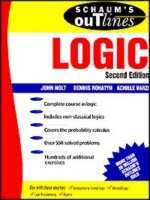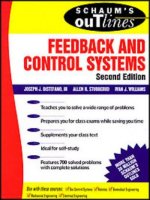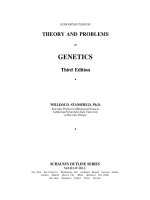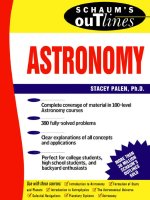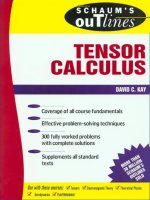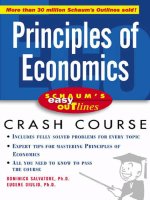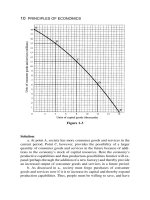- Trang chủ >>
- Khoa Học Tự Nhiên >>
- Vật lý
Schaum’s outline of theory and problems (5)
Bạn đang xem bản rút gọn của tài liệu. Xem và tải ngay bản đầy đủ của tài liệu tại đây (15.78 MB, 465 trang )
www.pdfgrip.com
I
SCHAUM’S OUTLZNE OF
THEORY AND PROBLEMS
OF
BASIC ELECTRICITY
MILTON GUSSOW, M.S.
Senior Engineer
Applied Physics Laboratory
The Johns Hopkins University
McGraw-Hill
New York San
Tokyo Toronto
www.pdfgrip.com
.
-
w
To Libbie, Myra, and Susan
MILTON GUSSOW is a senior
Naval
at Johns
B.S. (1949) from the U.S.
his B.S.E.E. (1956) from
(1957) from
in mathematics
elkctrical engineering. Mr. Gussow was
of over fifty technical
Schaum’s Outline of Theory and Problems of
BASIC ELECTRICITY
Copyright 0 1983 by The McGraw-Hill Companies, Inc.
of America.
as permitted
be reproduced or distributed in any form or by any
of the
system,
or stored in a data base or retrieval
16 17 18 19 20 BAW 9
I S B N 0-03-025240-8
Sponsoring Editor, John Aliano
Consulting Editor, Gordon Rockmaker
Editing Supervisor, Marthe Grice
Production Manager, Nick Monti
Library of Congress Catalogjng in Publication Data
Gussow, Milton.
Schaum’s outline of theory and problems of basic
electricity.
(Schaum’s
1 . Electricity. I. Title.
TK146.G974 1983
62 1.3‘02‘02
ISBN 0-07-025240-8
McGraw-Hill
82-467 1
E
A Division of 7-kMc#uw.Ha Companies
www.pdfgrip.com
Preface
This book is intended as a basic text to cover the fundamentals of electricity
and electric circuits. It may be used by beginning students in
schools,
technical institutes, and colleges who have no experience in electricity.
Explanations and step-by-step solutions are deliberately detailed so that the
text can stand alone. Thus it also may be used as a home-study or reference
book. A knowledge of basic algebra and trigonometry is assumed. Designed to
provide a broad and deep background in the nature of electricity and the operation and application of electric circuits, the text uses numerous and easy-tofollow examples accompanied by diagrams. Starting with the physics of electric
current flow, the book describes and analyzes both direct-current and alternating-current electric circuits, generators and motors, transformers, and measuring
instruments. To assure correlation to modern practice and design, illustrative
problems are presented in terms of commonly used voltages and current ratings,
covering circuits and equipments typical of those found in today’s electrical
systems.
There are several special features of this book. One is the use of the
International System of Units (SI) throughout. A second is the prolific use of
equation numbers for reference so that the reader will always know the source of
each equation used. Other features include simplified ways to solve problems on
three-phase transformer windings, series and parallel resonance, and RL and RC
circuit waveforms.
I wish to thank John Aliano, Gordon Rockmaker, and Marthe Grice of the
McGraw-Hill Book Company for their many constructive criticisms and continuing efforts to get this book published.
MILTON Gussow
www.pdfgrip.com
This page intentionally left blank
www.pdfgrip.com
Contents
Chapter
1
THE NATURE OF ELECTRICITY
.................................
Structure of the Atom ...................................................
The Electric Charge .....................................................
The Coulomb ...........................................................
The Electrostatic Field ...................................................
Potential Difference .....................................................
Current ................................................................
Current Flow ...........................................................
Sources of Electricity ....................................................
Direct
..............................
Chapter
2
ELECTRICAL
AND CONVENTIONS
..................
Units
Introduction ............................................................
Metric Prefixes ..........................................................
Powers of 10 ...........................................................
Scientific Notation .......................................................
Rounding Off Numbers ..................................................
Graphical Symbols and Electrical Diagrams
Schematic Diagram ......................................................
One-Line Diagram .......................................................
Block
..........................................................
Wiring
.........................................................
Electric Plan ............................................................
Chapter
3
OHM’S LAW AND
.......................................
The Electric Circuit .....................................................
Resistance ..............................................................
Fixed Resistors .........................................................
Variable Resistors .......................................................
Ohm’s Law .............................................................
Electric Power ..........................................................
Horsepower ............................................................
Electrical Energy ........................................................
Chapter
4
DIRECT-CURRENT
............................
Voltage. Current. and Resistance in Series Circuits ..........................
Polarity of Voltage Drops ................................................
Conductors .............................................................
Total Power in a Series Circuit ...........................................
Voltage Drop by Proportional Parts .......................................
www.pdfgrip.com
1
1
3
4
4
5
5
6
7
8
15
15
15
16
20
20
27
28
31
31
31
38
38
39
39
40
41
42
43
44
50
50
53
53
57
58
CONTENTS
Chapter
Chapter
5
6
DIRECT-CURRENT
CIRCUITS
........................
Voltage and
in a Parallel
...................................
Resistances in Parallel ...................................................
Open and Short
.................................................
Division of Current in Two
..............................
Conductances in Parallel .................................................
Power in Parallel
................................................
69
71
74
75
75
77
.....................................................
88
BATTERIES
The Voltaic Cell .........................................................
Series
.................................................
Primary
.............................................
Types of Batteries .......................................................
Battery
...................................................
Chapter
7
KIRCHHOFF’S LAWS
............................................
Kirchhoff’s Voltage Law (KVL) ..........................................
Kirchhoff’s Current Law (KCL) ..........................................
Mesh Currents ..........................................................
Node
..........................................................
Chapter
8
NETWORK CALCULATIONS
.....................................
Y and
...................................................
Superposition ...........................................................
Thevenin’s
.....................................................
Norton’s
.......................................................
Series-Parallel
...................................................
Wheatstone Bridge Circuit ...............................................
Maximum Power Transfer ................................................
Line-Drop
..................................................
Three-Wire
..........................................
Chapter
69
........................
9 MAGNETISM
The Nature of Magnetism ................................................
Magnetic Materials ......................................................
Electromagnetism .......................................................
Magnetic Units ..........................................................
BH Magnetization
................................................
Magnetic Circuits .......................................................
Electromagnetic
................................................
International
of Units .............................................
www.pdfgrip.com
88
89
90
90
94
101
101
103
104
106
116
116
120
122
124
126
128
129
130
131
162
162
163
164
167
168
170
172
174
CONTENTS
Chapter
10
.................
DIRECT-CURRENT
Motors
..................................................
Simple DC Generator ....................................................
Armature Windings ......................................................
Field Excitation ........................................................
DC Generator
..........................................
Generator Voltage Equations and Voltage Regulation .......................
Losses and Efficiency of a DC Machine ...................................
Direct-Current Motor ....................................................
DC Motor Equivalent
.............................................
Speed of a Motor .......................................................
Motor Types ............................................................
Starting
for Motors .........................................
Chapter
Chapter
Chapter
11
12
13
PRINCIPLES OF ALTERNATING CURRENT
.......................
184
184
185
186
187
188
189
189
191
192
193
194
1%
205
Generating
.........................................
Angular Measurement ...................................................
Sine Wave ..............................................................
Alternating
......................................................
Frequency
...................................................
Phase Relationships .....................................................
Phasors ................................................................
Characteristic Values of Voltage and Current ...............................
Resistance in AC Circuits ................................................
205
206
207
208
209
209
211
213
INDUCTANCE.
AND INDUCTIVE
CIRCUITS
Induction ...............................................................
Characteristics of Coils ..................................................
Inductive
.....................................................
Inductors in Series or Parallel ............................................
Inductive
.......................................................
Q of a Coil .............................................................
Power in RL Circuits ....................................................
225
225
226
227
228
231
237
237
.......................................................
205
CAPACITANCE.
.......................................................
Capacitor ...............................................................
Capacitance ............................................................
Types of Capacitors .....................................................
Capacitors in Series
..........................................
Capacitive
....................................................
Capacitive
......................................................
Power in RC Circuits ....................................................
www.pdfgrip.com
251
251
252
254
254
256
257
262
CONTENTS
Chapter
Chapter
14
15
Chapter
Chapter
16
17
.......................................
SINGLE-PHASE CIRCUITS
The General RLC Circuit ................................................
RLC in Series ..........................................................
RLC in Parallel .........................................................
R L and RC Branches in Parallel ..........................................
Power
.................................................
...........
ALTERNATING-CURRENT GENERATORS AND MOTORS
Alternators ..............................................................
Paralleling
....................................................
Ratings .................................................................
Losses and Efficiency ....................................................
Polyphase
...............................................
Synchronous
.....................................................
Single-Phase Motors .....................................................
................................................
TRANSFORMERS
Ideal Transformer Characteristics .........................................
Transformer
......................................................
Impedance
........................................................
Autotransformer ........................................................
Transformer
and Efficiency ........................................
No-Load
......................................................
Coil Polarity ............................................................
........................................
THREE-PHASE SYSTEMS
Characteristics of Three-Phase
...................................
Three-Phase
....................................
Power in Balanced Three-Phase
....................................
Unbalanced
...........................................
............................
Chapter
16
SERIES AND PARALLEL RESONANCE
Series Resonance .................................................
Q of Series Circuit ................................................
Parallel Resonance ................................................
Q of Parallel Circuit ..............................................
Bandwidth and Power of Resonant Circuit ..........................
Chapter
19
WAVEFORMS AND TIME CONSTANTS
RL Series
............................................
RL Time
......................................................
RC Series
............................................
RC Time Constants .....................................................
Calculation
Time r ...................................................
...........................
www.pdfgrip.com
275
275
275
278
280
282
300
300
302
303
303
303
306
310
322
322
325
326
326
327
328
329
339
339
340
342
346
362
362
365
366
369
370
384
384
388
390
393
394
CONTENTS
Chapter 20 ELECTRICAL MEASUREMENTS
..................................
Basic Measuring Instruments .............................................
Ammeters ..............................................................
Voltmeters .............................................................
Ohmmeters .............................................................
Multimeters .............................................................
Alternating-Current Meters ...............................................
Wattmeters and Watthour Meters .........................................
Analog Electronic Meters ................................................
Digital Meters ...........................................................
INDEX
..........................................................
www.pdfgrip.com
411
411
411
414
416
419
419
425
427
429
447
This page intentionally left blank
www.pdfgrip.com
Chapter 1
The Nature of Electricity
STRUCTURE OF THE ATOM
Matter is
that has
atoms. All matter
compounds. In an element, all the atoms are the same.
copper, carbon, germanium,
elements or
of elements are aluminum,
molecule.
Atoms are composed of subatomic
of electrons, protons, and neutrons in various
(-) of electricity. Electrons
combinations. The electron is the fundamental
in paths of concentric “shells,” or orbits (Fig.
revolve about the nucleus or center of the
(+) charge of electricity. Protons are found in the
1-1). The proton is the fundamental
nucleus. The number of protons within the
of any particular
14 protons in its nucleus so the
number of silicon is 14. The neutron, which is the fundamental
Nucleus
Electrons
Fig. 1-1 Electrons
an atom
of
Atoms of different
1-2). In its
state, an atom of any element
an equal
of
electrons and
(-) charge of each electron is equal in magnitude to the
positive (+) charge of each proton, the two opposite
1-2).
Example 1.1 Describe the two
1 proton in its nucleus
orbiting
(Fig. 1-2a). The
balanced by 2 electrons
by 1 electron
2 protons in its
1-2b).
has a certain amount of energy, which is equal to the sum of the
A stable
energies of its electrons. Electrons, in turn, have
energy levels. The
energy
of an
is proportional to its distance from the nucleus. Therefore, the energy
levels of electrons in shells farther from the nucleus are higher than those of electrons in shells
1
www.pdfgrip.com
2
THE NATURE OF ELECTRICITY
[CHAP. 1
Nucleus
Number of orbiting electrons
1
I/
(2 Protons, 2 Neutrons)
/ Orbiting electron
/
/
/
@
;
;
;
:
:
;
)
/
/
I
I
I
\
\
\
\
/
/
\
/
‘-/
/
(6)Helium atom, 2 orbiting electrons
(a) Hydrogen atom, 1 orbiting electron
Second shell
Second shell
I
I.
Third shell
\
/
I
/
/
Nucleus
(14 protons, 14 neutrons)
(d)Copper atom, 29 orbiting electrons
(c) Silicon atom, 14 orbiting electrons
Fig. 1-2 Atomic structure of four common elements
nearer
external energy
as heat, light, or electric
valence electrons. When
is applied to certain
excited state. An atom in an
state is unstable.
When an electron
moved to the outermost shell of its atom, it is least attracted by the
positive
of the protons within the
of its
If enough
is then
to
will leave
the atom, some of the outermost shell or valence
free electrons. It is the
of free electrons that provides
current in a
metal conductor.
of an
can contain
a certain maximum number of electrons.
Each
quota of a shell.
K,L, M,
is called
N, 0, P, and Q at increasing
filled with 2 electrons, the L
1-3). After
K shell
www.pdfgrip.com
3
THE NATURE OF ELECTRICITY
CHAP. I]
0
N
M
K
or
32
Nucleus
Fig. 1-3 Energy
shell
take up to 8 electrons.
8, 18, or 32 for different
maximum number of electrons in the remaining shells can be
8.
Example 1.2 Structure the copper
by identifying its energy
(Fig. 1-2d).
In the copper
there are 29 protons in the
29 orbiting
electrons fill the K shell with 2 electrons
8 electrons. The remaining 19 electrons
18 electrons, and
1 electron in the
N shell.
the M shell
If the quota is filled in the outermost shell of an atom, an element made up of such
to be inert. When the K shell is filled with 2 electrons, we have
1-2b). When the outer shell of an atom
If an atom
so that the
positive ion. If an atom gains electrons,
negative ion. The
by which atoms
gain or lose
called ionization.
Example 1.3 Describe
29
fill
is said
is
+ 1.
THE ELECTRIC CHARGE
Since
(-), electric
(+),
polarity.
When a pair of objects contains
objects are said to have like charges. When a pair of bodies
is negative (-), they
body is positive (+) while the
law of electric
may be stated as follows:
charges.
1 Like
(+) or both
is, one
said to have unlike or opposite
each other; unlike charges attract each other.
www.pdfgrip.com
(-), the
I
4
THE NATURE OF ELECTRICITY
[CHAP. 1
If a negative (-) charge placed next another negative (-) charge,
1-4a). If a positive (+) charge is placed next to a negative (-) charge,
1-4c).
together
Like - charges repel
Like
+ charges repel
(4
will be drawn
Unlike charges attract
(c)
(b)
Fig. 1-4 Force
THE COULOMB
The magnitude of electric
a body possesses
of electrons
compared
the number of protons within the
The symbol for the magnitude of the
electric
Q, expressed in units of coulombs (C). A charge of one
-Q,
means a body
a charge of 6.25 x 10" more electrons
Example 1.4 What the meaning of +Q?
A charge of one
electrons.
Example 1.5 A dielectric
coulombs?
Since the number of electrons
of 6.25 x 10l8 more protons
of 12.5 X 10'8 electrons.
a negative
is its
in
of 1 C (1 C = 6.25 x 10'* electrons), - Q = 2 C.
THE ELECTROSTATIC FIELD
The
of an electric
present within the electrostatic field surrounding
is its
to exert a force. This force is
1-5). The electric field is indicated by lines of force drawn
If an electron is released at point A in this field, it will be
by the
Electrostatic lines of force
Fig. 1-5 The
field between
*See page 16 for an explanation of how to use powers of 10.
www.pdfgrip.com
of opposite
5
T H E NATURE OF ELECTRICITY
CHAP. 11
and will be attracted to the
direction of motion that would be taken by the electron if it
electrostatic field.
1-5 indicate
in different areas of the
Example 1.0 Draw the electrostatic field that would exist between two negatively charged objects.
When two like charges are placed near each other, the lines of force repel each other as shown below.
<
A charged object will retain
to or
electricity.
if there is no immediate transfer of electrons
at rest. Electricity at rest is called static
POTENTIAL DIFFERENCE
Because of the force of its
potential. When one
field, an electric
is different
electromotive force (emf).
of potential
The basic
indicating the ability to do
voltage.
volt (V). The
for potential
is V,
Example 1.7 What is the meaning of a battery voltage output of 6 V?
A voltage output of 6 V means that the potential difference between the two terminals of the battery is
6 V. Thus, voltage is fundamentally the potential difference between two points.
CURRENT
The
current. To produce current, the
must
moved by a potential
Current
I. The
basic
in which current is measured is the
(A). One
of current is defined as the
movement of one
Example 1.8 If a current of 2 A flows through a meter for 1 minute (min), how many coulombs pass through
the meter?
1 A is 1 C per second (C/s). 2 A is 2 C/s. Since there are 60 s in 1 min, 60 x 2 C = 120 C pass through
the meter in 1 min.
The definition of current can
as an equation:
I = -Q
T
www.pdfgrip.com
6
THE NATURE OF ELECTRICITY
where
[CHAP. 1
I = current, A
Q = charge,
T = time, s
Q = I x T = IT
or
in that Q is
Charge differs from
intensity of moving charges.
Example 1.Q Find the
Write down the
( 1-21
accumulation of charge, while I measures the
to Example 1.8 by using
I = 2A
(1-2).
T=Ws
Q=?
Use Eq. (1-2) to solve for the
Q = I x T
Substitute I = 2 A and T = 60 s:
Q = (2A) x (60s)
Solve for Q:
Q = 120C
Ans.
CURRENT FLOW
In
a potential difference. If a
difference is connected
two ends
of a copper wire (Fig. M),the applied voltage (1.5 V) forces
a drift of electrons
-0, at one end of the wire, moving
through the wire, and returning to the positive charge, +Q, at the
end. The
of the
electron
is from
negative side of the
through the wire, and back to the positive
side of the
The
of electron flow is from a point of negative potential to a point
of positive potential. The solid arrow (Fig. 1-6) indicates
Conventional flow
+----
Electron flow
Free electrons
in motion
Copper wire
conductor
r
I
\
Potential
Battery cell
= 1.5 V
Fig. 1-6 Potential
across two
ends of a wire conductor causes
electric current
www.pdfgrip.com
THE NATURE OF ELECTRICITY
CHAP. I]
7
electron flow. The direction of moving positive charges,
from electron flow, is conconventional flow of current and is indicated by the
1-6). In
sidered
electricity,
are usually analyzed in terms of conventional
book current
always
considered as conventional flow.
SOURCES OF ELECTRICITY
Chemical Battery
A
chemical cell is a combination of materials which are used for converting chemical
is formed when two or more cells are connected. A
energy. A
energy into
chemical reaction
1-7). The metals are in contact with an electrolyte.
Metal
Electrolyte
Fig. 1-7 Voltaic
cell
Generator
The
is a machine in which electromagnetic inductance is used to produce a voltage by
rotating coils of wire through a
magnetic field or by rotating a magnetic field through
stationary coils of wire. Today more than 95 percent of the world's energy is produced by
generators.
Thermal Energy
The
of most electric energy begins with the formation of heat energy. Coal, oil, or
natural gas can be burned to release large quantities of heat. Once heat energy is available,
conversion to mechanical energy is the next step. Water is heated to produce steam, which is then
used to turn
direct conversion from heat energy
to electric energy will increase efficiency and reduce thermal pollution of water
and the
atmosphere.
Magnetohydrodynamic (MHD)Conversion
In MHD converter, gases are ionized by very high temperatures, approximately 3000 degrees
Fahrenheit (3000°F), or 1650 degrees Celsius (1650'C). The hot gases pass through a strong
magnetic field with current resulting. The
1-8). MHD converters have no mechanical moving parts.
Thermionic Emission
The thermionic energy converter
emitter
a device that
www.pdfgrip.com
of two electrodes in a vacuum. The
T H E NATURE OF ELECTRICITY
[CHAP. 1
Fig. 1-8 Principles of M H D converter
Solar Cells
Solar cells convert light energy directly into electric energy. They consist of semiconductor
Solar cells are
material like
Piezoelectric Effect
Certain crystals, such as quartz and Rochelle salts, generate a voltage when they are vibrated
mechanically. This action is known as the piezoelectric efect. One example is the crystal
phonograph cartridge, which contains a Rochelle salt crystal to which a needle is fastened. As the
from side to side. This mechanical motion is
needle moves in the grooves of a record, it
applied to the crystal, and a voltage then generated.
Photoelectric Effect
Some materials, such as zinc, potassium, and cesium oxide, emit electrons when light strikes
their surfaces. This action is known as the photoelectric efect. Common applications of photoelectricity are television camera tubes and photoelectric cells.
Thermocouples
If wires of two different metals, such as iron and copper, are welded together and the joint is
heated, the difference in electron activity in the two metals produces an emf across the
joint. Thermocouple junctions can be used to measure the amount of current because current acts
to heat the junction.
DIRECT AND ALTERNATING CURRENTS AND VOLTAGES
Direct current (dc) is current that moves through a conductor or circuit in one direction only
(Fig. 1-90). The reason for the unidirectional current is that voltage sources such as cells and
batteries maintain the same polarity of output voltage
1-9b). The voltage supplied by these
sources is
direct-current voltage, or simply dc uoltage. A dc voltage source can change the
amount of its output voltage, but if the same polarity is maintained, direct current will flow in one
direction only.
www.pdfgrip.com
9
THE NATURE OF ELECTRICITY
CHAP. 11
dc Current
+ I
dc Voltage
+ v
9
Magnitude
of current
V
'
1 Magnitude
of voltage
-T
6
0
Time
0
+
Fig. 1-9 Waveforms of a constant
dc voltage
Example 1.10 Assuming the polarity of the
current and
With polarity reversed, the current will now flow in the
o
r
Fig. 1-9b,draw
v~
new curves of
0~
- v
- I
dc Current
dc
An alternating-current
(ac voltage)
periodically reverses or alternates in polarity
(Fig. 1- 10a). Therefore, the resulting
current also
reverses direction
1-lob). In terms of conventional flow, the current flows from
common
these systems.
The voltage
power line
in most
is a
current direction go through many reversals each second in
ac
ac Current
(b)
(0)
Fig. 1-10 Waveforms of ac voltage
www.pdfgrip.com
ac current
10
THE NATURE OF ELECTRICITY
[CHAP. 1
Solved Problems
1.1
meaning in column 2.
Match each term in column 1 to its
Column 1
Electron
Neutron
Compound
Neutral
Valence electrons
Atomic number
Free
K shell
Ion
Inert
1.
2.
3.
4.
5.
6.
7.
8.
9.
10.
(a)
(b)
(c)
(d)
(e)
cf)
(8)
(h)
(i)
(j)
(k)
(I)
(m)
Ans.
1.2
1. (i)
Column 2
Positive charge
Same number of electrons and protons
Electrons in first shell
Released electrons
Neutral
Electrons in outermost shell
Quota filled in outermost shell
Number of electrons in nucleus
Negative charge
Quota of 2 electrons
Combined elements
Number of protons in nucleus
Charged atom
7. ( d ) 8. (j) 9. (m) 10. (g)
3. (k) 4. ( b ) 5 . (f) 6 . (I)
2. (e)
Show the
electron
of the element aluminum with atomic number 13. What is its
Because aluminum has 13 protons in the
electrically
it must have 13 orbiting
1-3), we have
K shell
L shell
M shell
Total
2 electrons
8 electrons
3 electrons
13 electrons
The atomic structure for aluminum then is shown in Fig. 1-11. Its electron
has 3 valence
/&,
' -0".
Q
,'a ,&,
I
/
//
i
/
I
\
/
/
\
\
\
\
\
L
\
\
M
\
3 electrons in 18-electron
shell
'
/-
\
\
to be
2-electron
-0-2,.
'.--/\
8-electron
Fig. 1-11
www.pdfgrip.com
-3 because it
CHAP. I]
1.3
11
T H E NATURE OF ELECTRICITY
In observing the maximum number of electrons in shells K, L, M,and N in Fig. 1-3, you will
find that they are 2, 8, 18, and 32 electrons, respectively.
a formula that describes
n is the shell
in sequential order outward
the nucleus.
this
The
2n2 because the maximum number of electrons in the
K or
shell (n = 1) is
= 2(1) = 2
L or
shell (n = 2) is 2(23 = 2(4) = 8
M or
shell (n = 3) is 2(33 = 2(9) = 18
N or fourth shell (n = 4) is 2(43 = 2(16) = 32
This
1.4
What is the net charge of a body that contains 8 protons and 4 electrons?
The numerical
of the net charge is found by
from the number of the other type. So a
yields
4 (+4).
1.5
the number of one type of charge
8 (+8) and
4 (-4)
50 x 10l8 electrons.
A charged
with
its charge in coulombs
Since C = 6.25 x 10" electrons, 8 C = 50 x 10" electrons. Deficiency of electrons
excess of protons. So the
8 C, or + Q = 8 C.
1.6
Write the word
( a ) A rubber
so both
fur. If the
( b ) Glass
the glass
( a ) like (law of charges);
1.7
an
rod is negative,
(b) positive (law of charges)
Find the current needed to charge a dielectric so that it will accumulate a charge of 20C
after 4 s.
Known
Unknown:
Q = 20C; T = 4 s
I=?
Use Eq. (1-1) to find I:
I = - = - -* O C - 5 A
T
4s
1.8
Ans.
A current of 8 A charges an insulator for 3 s. How
Known
Unknown:
I = 8 A; T = 3 s
Q=?
Use Eq. (1-2) to find Q:
Q
1.9
Write the word or words
( a ) The
=
IT = (8 A)(3 s) = 24 C
Ans.
correctly complete each of the following statements.
of a charge to do work is its
www.pdfgrip.com
THE NATURE OF ELECTRICITY
12
[CHAP. 1
When one charge is different
of charges
value for the current.
a
A greater amount of moving charges
When the potential
is
The rate of flow of charge is called
The direction of the
flow of current is from a point of
potential.
potential to a point of
Electron flow is opposite in direction to
flow.
direction.
Direct current (dc) has just
is an example of a dc voltage source.
A
its polarity.
An alternating current (ac)
( a ) potential
(b) difference, potential
(c) volt
(d) electromotive force
(e) current
(f) higher
( h ) current
(i) positive, negative
(j) conventional
(k) one
( I ) battery
(m) reverses
( 8 ) zero
1.10
Match each device in column 1 to its closest principle in column 2.
1.
2.
3.
4.
5.
Column 1
Battery
Generator
TV camera tube
Vacuum tube
Phonograph
(a)
(b)
(c)
(d)
(e)
cf)
(g)
Ans.
1. ( d ) 2 . (a) 3.
(1)
Column 2
Electromagnetic
Free electrons
Ionized
Chemical
Thermal
Photoelectricity
Mechanical
4. ( b ) 5 . ( g )
www.pdfgrip.com
THE NATURE OF ELECTRICITY
CHAP. I]
Supplementary Problems
1.11
Match
2
1. Proton
( a ) Negative
(b) Quota of 8 electrons
(c) Excited state
( d ) Maximum number of electrons in a shell
(e) Atom negatively
cf) Positive
(g) Mass and volume
( h ) Atomic number is 29
(i) Quota of 18 electrons
(j) Orbit
(k) Smallest
having same
characteristics
(I) Atomic
is 14
(m) All atoms
2. Molecule
3. Quota
4. L shell
5. Element
6. Unstable
7. Shell
8. Copper
9. Negative
10. Matter
Ans. 1. cf) 2. (k) 3. ( d ) 4. ( b ) 5. (m) 6. (c)
1.12
Write
7. (j) 8. ( h ) 9. (e)
10. ( g )
word or words which most
( a ) Electrons move about the
of an atom in paths which are
(b) The nucleus of an atom consists of particles called
(c) The
of protons in the
of an atom is known as the
of that
( d ) When all the
within a substance are alike,
(4 A
cf)
(8)
(h)
(i)
(j)
is
compound.
of an electron
The energy
atom.
If a neutral
If a neutral
Unlike charges
each other, while like charges
A charged object is surrounded by an
field.
Ans. ( a ) shells or orbits
(b) protons,
( c ) atomic
( d ) element
(e) molecule
each
cf) level
(8) negative
(h) positive
(i) attract, repel
(j) electrostatic
1.13
Show the atomic structure of the element
which has an atomic
Ans. See Fig. 1-12. Electron
-5.
electron
1.14
Show the
valence?
1.15
What is
of 15. What is its
structure of the element
which has
of 10. What is its
Ans. See Fig. 1-13. Electron
0. Thus, neon is inert.
if 13 electrons are added to 12 protons?
www.pdfgrip.com
Ans. -1 electron
14
THE NATURE OF ELECTRICITY
Fig. 1-12
1.16
[CHAP. 1
Fig. 1-13
What becomes of the
Ans. It
of -4.
Fig. 1-2c.
1.17
A charged
Ans. - Q = 4 C
1.18
A material with an excess of 25 x 10'' electrons
6.25 x 10l8electrons. The excess electrons are
then
to flow past a given point in 2s. Find the current produced by the resultant
~ n s .r = 1 . 5 ~
flow.
1.19
A charge of 10 C flows past
1.20
How much charge
Ans. Q = 2 5 C
1.21
Match
2. Cesium
3. Silicon
1.22
given point
2 s. What
Section 2
Solar cell
(b) Generator
( c ) Battery
( d ) Crystal
(a)
3. (a) 4. (d) 5. (c) 6. ( h )
Fill in the missing quantity:
1, A
Q,C
?
10
?
9
?
5
?
7
2
Ans. I = 5 A
in section 2.
Section 1
4. Quartz
5. Carbon-zinc
6. Iron-copper
1. (f) 2. (e)
the current?
of 5 A charges an insulator for 5 s?
item in section 1 with its
1. Water
Ans.
of 25 x 10" electrons. Find its charge in coulombs with polarity.
6
Ans.
2
4
2
3
?
-
www.pdfgrip.com
Photoelectric sell
(f) Turbine
(g) MHD converter
( h ) Thermocouple
(e)

